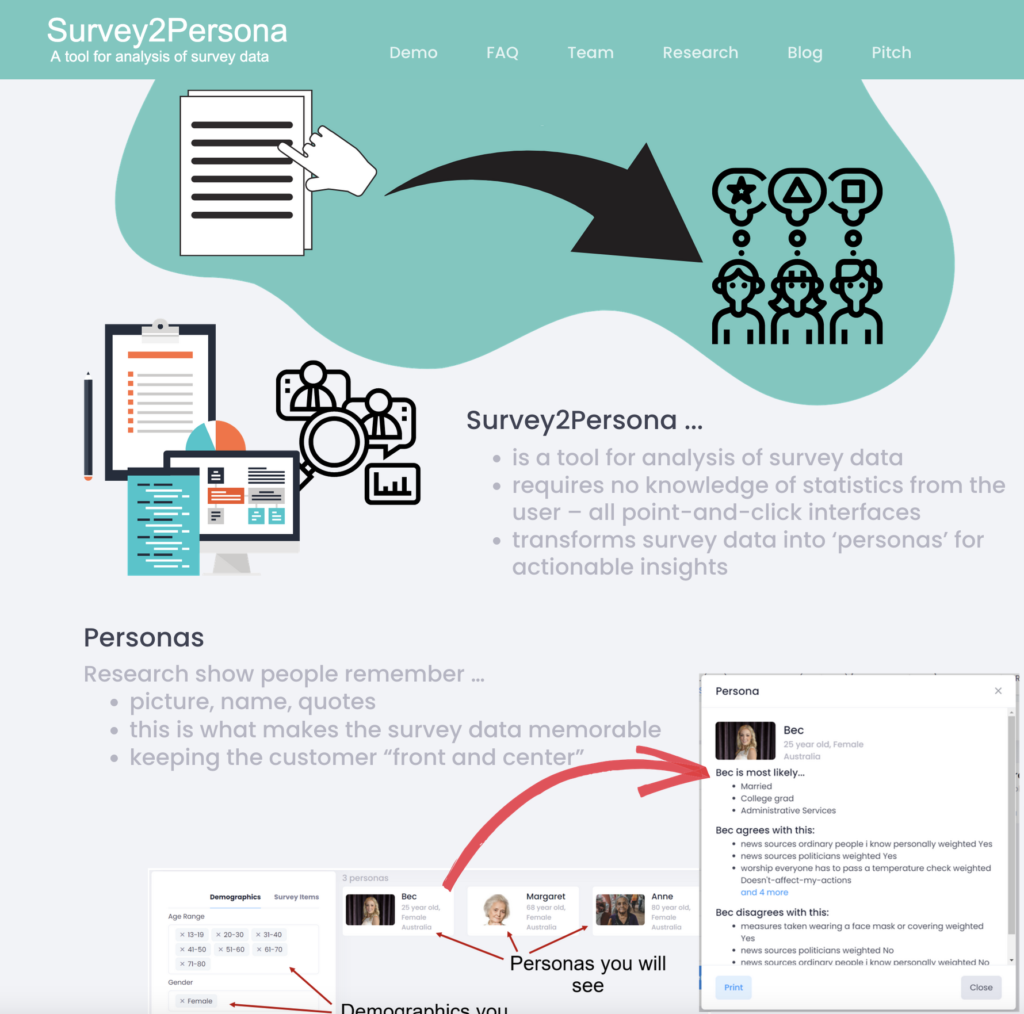
The human-computer interaction (HCI) persona is an archetypal character representing a user group based on demographics, goals, attitudes, and behaviors when interacting with a particular product or service. As discussed below, prior research found that personas are an effective way to organize and communicate survey data. We describe below several examples of research that created personas based on survey data and outline the benefits of creating survey-based personas:
Example 1- Water Awareness [1]:
Survey: 1,000 survey respondents were asked about socioeconomic conditions, knowledge, attitudes, and behaviors regarding safe water
Personas: Personas were derived from the survey data. Each persona included: a name, photo, demographical data, water awareness, water source, water storage, and current water treatment.
Benefits of survey-based personas:
- Segment users based on survey questions.
- Analyze survey data through the lens of users’ segmentation.
- Emphasize key differences in personas representing different groups.
Example 2- Digital Exclusion [2]:
Survey: 338 survey respondents were asked about demographics, technology access, and use, technology activities, attitudes towards technology, technical competence, and sensory, motor, and cognitive capabilities.
Personas: Personas were derived from the survey data. Each persona included: a name, photo, lifestyle, competence with technology, use of technology, physical and sensory capabilities, and attitude toward technology.
Benefits of survey-based personas:
- Bring the range of digital expertise to life and highlight people at risk of digital exclusion.
- Differentiate Personas by many criteria such as not just by levels of technical competence but also by experience and attitudes toward technology.
- Show the proportion of the population represented by each persona based on each digital expertise variable and, thus, the scale of potential digital exclusion.
Example 3- Elderly ICT users [3]:
Survey: 551 survey respondents were asked about demographics, ICT devices and applications, health information, technology affinity, health literacy, and computer literacy.
Personas: Personas were derived from the survey data. Each persona included: a name, photo, demographical information, personal background, health status, health-related information, and attitude to technical devices.
Benefits of survey-based personas:
- Gain a better understanding of a project.
- Focus on the needs of the users.
Example 4- Millennials’ Media Usage [4]:
Survey: 453 survey respondents were asked about demographics, degree of interest in the media, media in use, contexts of using the products, and purpose of consuming music
Personas: Personas were derived from the survey data. Each persona included: a name, photo, demographical information, characteristics related to music, device, and personality.
Benefits of survey-based personas:
- Develop market products and services according to the characteristics of each millennials group (For example, young vs. older groups).
Example 5- Game Preference [5]:
Survey: 15,402 survey respondents were asked about demographics (age and gender) and preferences in gameplay elements.
Personas: Personas were derived from the survey data. Each persona included: a name, photo, education level, and favorite games.
Benefits of survey-based personas:
- Target players based on interest in specific games to decrease the cost of new player acquisition.
- Recommend video games to players based on the persona they are most similar with.
- Reduce stereotypical thinking, such as gender stereotyping.
These case studies illustrate that converting survey data to personas has value for researchers and product designers.
Therefore, we propose Survey2Persona (S2P), an interactive web system enables the designer to upload survey data about users and generate personas from this data without making any complex technical choices (the system is available online at: https://s2p.qcri.org)
S2P [6] has several benefits, including:
- S2P is the first interactive persona system to our knowledge that generates personas in real time from survey data.
- S2P provides a fast and responsive interface to generate the personas based on specific demographics or survey items in the dataset.
References:
[1] Putnam, G., Kolko B., and Wood. S. 2012. Communicating about users in ICTD: leveraging HCI personas. In Proceedings of the Fifth International Conference on Information and Communication Technologies and Development (ICTD ’12). Association for Computing Machinery, New York, NY, USA, 338–349. https://doi.org/10.1145/2160673.2160714
[2] Goodman-Deane, J., Bradley, M., Waller, S., & Clarkson, P. 2021. Developing personas to help designers to understand digital exclusion. In Proceedings of the Design Society, 1, 1203-1212. doi:10.1017/pds.2021.120
[3] Schäfer, K., Rasche, P., Bröhl, C., Theis, S., Barton, L., Brandl, C., Wille, W., Nitsch, N and Mertens, A. 2019. Survey-based personas for a target-group-specific consideration of elderly end users of information and communication systems in the German health-care sector. International Journal of Medical Informatics, 132, 103924
[4] Lee, M., Kwahk, J., Han, S., Jeong, D., Park, D., Oh, S., and Chae, G. 2020. Developing personas & use cases with user survey data: A study on the millennials’ media usage. Journal of Retailing and Consumer Services, 54, 102051
[5] Salminen, J., Vahlo, J., Koponen, A., Jung, S., Chowdhury, S., and Jansen, B. 2020. Designing prototype player personas from a game preference survey. In Extended Abstracts of the 2020 CHI Conference on Human Factors in Computing Systems (CHI EA ’20). Association for Computing Machinery, New York, NY, USA, 1–8. https://doi.org/10.1145/3334480.3382785
[6] Salminen, J., Jansen, B., and Jung, S. 2022. Survey2Persona: rendering survey responses as personas. In Adjunct Proceedings of the 30th ACM Conference on User Modeling, Adaptation and Personalization (UMAP ’22 Adjunct). Association for Computing Machinery, New York, NY, USA, 67–73. https://doi.org/10.1145/3511047.3536403

